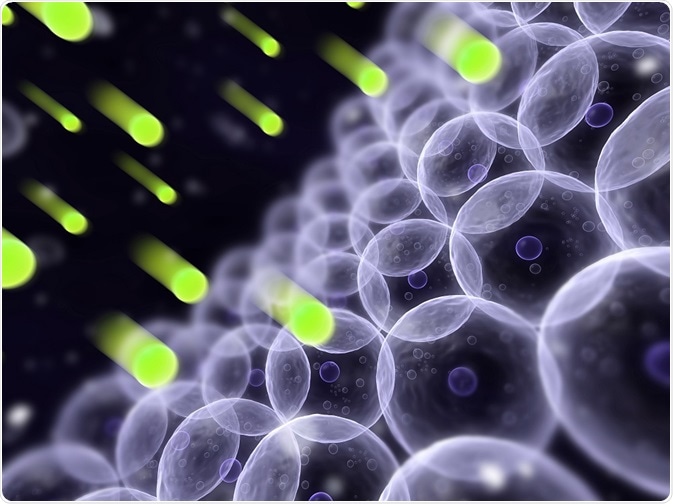Electron paramagnetic resonance (EPR) is a method used to detect unpaired electrons or free radicals.
 Credit: Sebastian Kaulitzki/Shutterstock.com
Credit: Sebastian Kaulitzki/Shutterstock.com
EPR spectroscopy has been employed in pharmaceutical applications to analyze the toxic side effects caused by the formation of free radicals. The methodology is also being used to devise better drug sterilization techniques, reducing the risk of free radical formation by irradiation.
EPR is a non-destructive method for understanding drug delivery systems through the measurement of important characteristics that affect drug potency and distribution.
Why EPR can be applied to the field of pharmacology
The formation of free radicals has long been associated with the toxic side effects of drugs. Evidence for this proposal was finally supplied in 1995 with the detection of drug-derived free radicals reported in a topical treatment for skin psoriasis.
EPR spectroscopy can be employed in the direct measurement of short-lived free radicals within drug systems. The method works by detecting unpaired electrons within a magnetic field, where the magnetic moment of the unpaired electrons can align in either a parallel or an antiparallel direction.
The two directions are associated with a lower and upper energy state respectively. Unpaired electrons can transition between lower and upper energy states through the absorption or emission of a photon.
The transition from the original lower state to the upper state occurs when the external magnetic field reaches a specific strength threshold.
EPR spectroscopy records the net absorption of energy that occurs during the transition when the magnetic field is varied and the level of irradiation remains stable. The transition between energy states is then converted into an EPR spectrum for analysis.
EPR spectroscopy and radiation sterilization
EPR spectroscopy is utilized for characterizing free radicals formed from drug sterilization procedures. Gamma radiation is commonly employed during drug sterilization procedures but is noted to produce both short-lived and stable free radicals.
This is problematic for the pharmaceutical industry because free radicals can interact with drug molecules causing degradation of the active pharmaceutical ingredient and potentially producing toxic side effects from polymer disintegration.
Moreover, common dry solid dosage forms such as tablets have been found to retain irradiated free radicals for long periods of time. EPR spectroscopy is a useful tool for detecting free radicals formed from radiation sterilization techniques.
The methodology is also being applied to finding the most appropriate radiation dose for sterilization without the production of free radicals. By re-irradiating drug substances with specific exposure amounts the resulting EPR signals can be compared, providing a rigorous test of free radical formation from radiation sterilization.
EPR spectroscopy and drug delivery
EPR spectroscopy supplies a non-destructive method for the analysis of drug delivery systems. It can be applied to numerous dosage forms including whole tablets, suspensions and solutions.
Though most drug delivery systems contain no unpaired electrons and are therefore unable to be analyzed by EPR spectroscopy, the addition of free radicals as reporter molecules have increased application.
Spin probes contain reactive functional groups that allow the attachment of larger biomolecules through a process known as spin labeling. The employment of spin probes means that EPR spectroscopy can be used to measure drug delivery system characteristics such as microacidity and micropolarity, along with providing greater understanding of drug diffusion mechanics.
EPR imaging and the spatial distribution of drug characteristics
The spatial distribution of important drug characteristics such as radical concentration, microviscosity and microacidity can also be examined through EPR imaging.
There are two techniques by which spectral-spatial EPR imaging provides locally encoded EPR spectra:
The first utilizes a rotation constant gradient where two and three dimensional spatial images are formed from EPR spectra by maintaining a constant distance. The second employs a variable gradient to produce one dimensional spatial-spectral EPR images at various distances.
Both methods require image reconstruction techniques to process the EPR spectra into images. The rotation constant gradient EPR imaging supplies both the distribution and location of paramagnetic centres within a sample.
Nonetheless, the technique has the disadvantage of spectral information loss reducing its applicability for providing information on factors such as pH and polarity.
Introduction to Electron Paramagnetic Resonance - Yale CBIC
Sources:
- Eaton, S.S. & Eaton, G.R. 2012. Electron Paramagnetic Resonance, Characterization of Materials, pp. 1-13.
- Mader, K. 1998. Pharmaceutical applications of in vivo EPR, Physics in Medicine and Biology, 43, pp. 1931-1935.
- Kempe, S. et al. 2010. Application of electron paramagnetic resonance (EPR) spectroscopy and imaging in drug delivery research - chances and challenges, European Journal of Pharmaceutics and Biopharmaceutics, 74, pp. 55-66.
- Abuhanoğlu, G. & Yekta Özer, A. 2014. Radiation sterilization of new drug delivery systems, Interventional Medicine and Applied Science, 6, pp. 51-60.
Further Reading